Comments / Questions (46)
![]() BRIGITTE HOREL wrote:
BRIGITTE HOREL wrote:
Bonjour impossible de comprendre le biais de l'épaule droite 1er rang sur l'endroit je tricote 26m pour ma taille et je tourne il me reste 2m sur l'autre aiguille Rang 2 j'exécute le rang raccourci ce qui me fait 2 mailles au début de mon rang et je fini mon rang entièrement j'ai du coup 29mailles Rang 3 sur l'endroit on me dit de tricoter 24m et donc je n'atteint pas mes 2 mailles du rang raccourci la je ne comprends pas
14.12.2024 - 05:06DROPS Design answered:
Bonjour Mme Horel, en XL, tricotez l'épaule droite, en commençant sur l'endroit ainsi: tricotez 26 m, tournez et tricotez le rang retour (utilisez la technique des rangs raccourcis de votre choix), tricotez 24 m (2 m en moins qu'au rang précédent), tournez et tricotez le rang retour et continuez ainsi en tricotant 18 puis 14, puis 10 et enfin 6 m - vous avez tricoté 14 rangs au total; Bon tricot!
16.12.2024 - 09:56
![]() Lotta wrote:
Lotta wrote:
Stämmer det att man ska göra minskningar på höger axel från rätsidan? Då hamnar ju minskningar i de 6 kanstmaskorna. Alltså ytterst på axeln.
24.11.2024 - 18:50DROPS Design answered:
Hej Lotta, höger axel när plagget tas på: HÖGER SNED AXEL: Sticka sned axel med German Short Rows så här: VARV 1 (= rätsidan): Sticka 22-23-24-26-27-29 maskor från rätsidan som tidigare, vänd, VARV 2 (= avigsidan): Lyft över första maska på stickan som om den skulle stickas avig med tråden framför arbetet, strama väl tills så att det ser ut som att det är 2 öglor på stickan, sticka varvet ut från avigsidan som tidigare.
27.11.2024 - 14:43
![]() Elisabet Cullbrand wrote:
Elisabet Cullbrand wrote:
Hejsan Stämmer det att man ska använda stickor 3 på resår vid start? Jag har provstickat slätstickning och mitt garn stämmer men vid ressårstickning på stickor 3 blir arbetet väldigt mkt mindre och blir tveksam att det blir bra. Vilket mått ska resår ha för att stämma överens med mönster och respektive storlek? Mvh Lisa
17.11.2024 - 08:41DROPS Design answered:
Hej Elisabeth, Hvis du strikker i 1 tråd DROPS Alpaca og 1 tråd DROPS Kid- Silk på pind 4,5 i glatstrik, så får du 18 masker på 10 cm i bredden. Det resårstrikkede bliver elastisk og skal trække arbejdet sammen, så det kommer til at se ud som på billedet :)
22.11.2024 - 14:31
![]() Katie wrote:
Katie wrote:
Thanks for the pattern! Not sure if I am missing it, but is there a rough estimate on where lengthwise to put the button holes? How far up the band from the bottom?
28.10.2024 - 20:18DROPS Design answered:
Dear Katie, sure, you will find all informations about buttonholes: how to work them and where to work them under BUTTONHOLES at the very beginning of the pattern, under section EXPLANATIONS FOR THE PATTERN. Happy knitting!
29.10.2024 - 09:09
![]() Pirjo Nurmi wrote:
Pirjo Nurmi wrote:
TAKAKAPPALE: Neulo seuraava kerros (= oikea puoli) näin: Neulo vasemman olan silmukat kuten aiemmin, luo 28-30-32-32-34-34 silmukkaa, neulo oikean olan silmukat (työn oikealta puolelta) = 84-88-92-96-100-104 silmukkaa. Tässä on ohjeteksti, miten olkasilmukat 2 x28. On tässä ohjeessa 84. Siis mistä lisäsilmukat otetaan ???
27.10.2024 - 17:51DROPS Design answered:
Hei, olkapäiden silmukoiden väliin luodaan 28 uutta silmukkaa.
29.10.2024 - 16:25
![]() Pirjo Nurmi wrote:
Pirjo Nurmi wrote:
Onko liivin pinta sileää vai onko koko työ kudottu aina oikein molemmin puolin?
24.10.2024 - 11:38DROPS Design answered:
Hei, liivi neulotaan joustinneuleen jälkeen sileänä neuleena. Etureunojen silmukat neulotaan kuten aiemmin.
24.10.2024 - 18:39
![]() Pirjo Nurmi wrote:
Pirjo Nurmi wrote:
Minulle ei oikein selvinnyt , onko liivi resorin jälkeen kudottu molemmilta puolin oikeaa? Kohdassa kainalon neulos, sanotaan : neulo 7- 8 .. silmukkaa ja sitten sileää neuletta🤔 Missä ymmärrä väärin Please help. Kiitos
24.10.2024 - 07:34
![]() Ching wrote:
Ching wrote:
Sorry I still cannot understand. Your reply is on thr right shoulder. But the pattern wrote on Left shoulder short rows is: ROW 1 (=wrong side),ROW 2 (=right side). If I start to work 24sts on Row 1 ,wrong side , I ended on the bands stitches.
15.10.2024 - 16:50DROPS Design answered:
Dear Mrs Ching, if you start with left shoulder, the result should be the same starting from wrong side: you will work more rows starting from armhole leaving stitches unworked towards neck. Happy knitting!
16.10.2024 - 07:21
![]() Ching wrote:
Ching wrote:
I am knitting size L. Before the short Row, there are 26 sts left on the needles( 20 sts and 6 band sts) Then Row 1( WS) told to knit 24 sts , but it will end on the band sts. I can't understand this part. Please advise. Thanks
14.10.2024 - 23:32DROPS Design answered:
Dear Mrs Ching, start working the short rows from RS not from WS, so work the 24 first sts from WS (2 sts remain unworked on left needle), turn and work next row, then work the first 22 sts at the beg of next row from RS, turn and work return row and continue like this working 20 sts, then 16 sts, then 12 sts and 8 sts and 4 sts. Happy knitting!
15.10.2024 - 10:17
![]() Ching wrote:
Ching wrote:
I don't understand the RIGHT DIAGONAL SHOULDER written in the pattern. On Row 1, told to work 24 sts from the right side and turn. But on Row 3 told to work 22 sts and turn. How can it be? I can't knit to the 2 loops on the needles and k2tog. On the videos, it's show knit to the 2 loops on the needles and K2tog, k3 and turn. Please advise. Thanks
14.10.2024 - 23:02DROPS Design answered:
Dear Mrs Ching, the 2 loops are created by working the short rows with the german technique - see video; for right shoulder you will work always less stitches starting from RS so that there will be more rows worked towards armhole for the whole shoulder front then back piece. The 2 loops will be worked together only when you work this stitch again, not as along as you will work less stitches. Happy knitting!
15.10.2024 - 10:14
Driftwood Vest#driftwoodvest |
|
 |
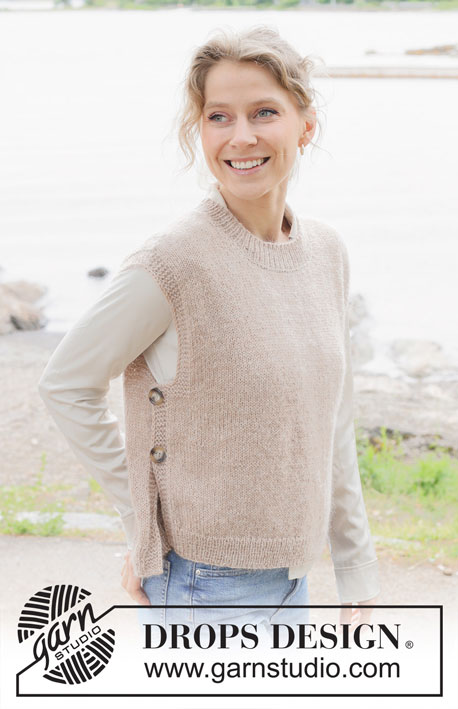 |
Knitted vest in DROPS Alpaca and DROPS Kid-Silk or DROPS Flora and DROPS Kid-Silk. The piece is worked with diagonal shoulders. Sizes S - XXXL.
DROPS 255-9 |
|
|
------------------------------------------------------- EXPLANATIONS FOR THE PATTERN: ------------------------------------------------------- BANDS WITH I-CORD BEGINNING OF ROW: Slip 1 stitch purl-wise with strand in front, knit 1, work 4 garter stitches. END OF ROW: Work until there are 6 stitches left on the row, work 4 garter stitches, slip 1 stitch purl-wise with strand in front, knit 1. Work in the same way from both the right and wrong side. GARTER STITCH (worked back and forth): Knit all rows, from both the right and wrong side. 1 ridge in height = knit 2 rows. BUTTONHOLES: Work the buttonholes on both bands from the right side. ROW 1 (right side): Knit together the 4th and 5th stitch from the edge, make 1 yarn over, work until there are 5 stitches left on the row, make 1 yarn over, knit 2 together and finish the band as before. ROW 2 (wrong side): Work both bands as before, knitting the yarn overs to leave holes. The first set of buttonholes is worked when the piece measures 19-20-21-22-23-24 cm, the second set when the piece measures 28-29-30-31-32-33 cm. KNITTING TIP: When working short rows, there will be a slight hole after each turn. The holes can be closed by tightening the strand or working the technique German Short Rows as follows: Slip the first stitch purl-wise, lay the strand over the right needle and tighten well at the back (2 loops on the needle which are knitted together on the next row). ------------------------------------------------------- START THE PIECE HERE: ------------------------------------------------------- VEST - SHORT OVERVIEW OF THE PIECE: The piece is worked back and forth. The front piece is worked bottom up to the neckline, then the diagonal shoulders are worked separately. The shoulders are joined before working the back piece, top down. The back piece is longer than the front piece. Stitches are knitted up around the neckline before working the neck. FRONT PIECE: Cast on 113-119-129-139-151-165 stitches with circular needle size 3 mm, and 1 strand DROPS Alpaca and 1 strand DROPS Kid-Silk (= 2 strands), or 1 strand DROPS Flora and 1 strand DROPS Kid-Silk (= 2 strands). Work rib, starting from the wrong side as follows: Work 6 stitches according to BANDS WITH I-CORD – read description above, work rib (purl 1, knit 1) until there are 7 stitches left, purl 1 and 6 stitches according to bands with I-cord. Work the rib and the bands with I-cord for 5 cm. Change to circular needle size 4.5 mm. Work 1 row of stocking stitch with the bands as before. AT THE SAME TIME decrease 15-15-17-19-21-23 stitches evenly on the first row (do not decrease across the bands) = 98-104-112-120-130-142 stitches. Continue with stocking stitch and 6 band-stitches as before on each side – remember the BUTTONHOLES and remember to maintain the knitting tension. When the piece measures 28-29-30-31-32-33 cm, continue as follows: Work 6 band-stitches as before, 7-8-10-12-15-19 GARTER STITCHES – read description above, work stocking stitch until there are 13-14-16-18-21-25 stitches left, 7-8-10-12-15-19 garter stitches and 6 band-stitches as before. When the piece measures 30-31-32-33-34-35 cm, cast off on each side for the armholes as follows: ROW 1: Knit 2 together (= 1 stitch decreased), cast off 6-7-9-11-14-18 stitches, work as before to end of row = 91-96-102-108-115-123 stitches. ROW 2: Knit 2 together (= 1 stitch decreased), cast off 6-7-9-11-14-18 stitches, work as before until there are 6 stitches left, work 6 band-stitches as before = 84-88-92-96-100-104 stitches. Continue with stocking stitch back and forth and 6 band-stitches as before on each side. When the piece measures 46-47-48-49-50-51 cm, work from the right side, placing AT THE SAME TIME the middle 24-24-26-26-28-28 stitches on a thread for the neckline and finishing each shoulder separately. RIGHT SHOULDER (when garment is worn): = 30-32-33-35-36-38 stitches. The first row = wrong side. Continue with stocking stitch and the band as before. AT THE SAME TIME cast off for the neckline as follows: Cast off the first stitch from the neck every 2nd row 5-6-5-5-5-5 times, then every 4th row 1-1-2-2-2-2 times = 24-25-26-28-29-31 shoulder-stitches. Continue with stocking stitch and the band as before. When the piece measures 51-53-55-57-59-61 cm, read KNITTING TIP, then work RIGHT DIAGONAL SHOULDER as described below, with the first row from the right side. RIGHT DIAGONAL SHOULDER: Work short rows with turning stitches/German Short Rows as follows: ROW 1 (= right side): Work 22-23-24-26-27-29 stitches as before, turn, ROW 2 (= wrong side): Slip the first stitch purl-wise, with strand in front, tighten the strand over the right needle (2 loops on the needle) and work to end of row as before. Continue like this back and forth, with fewer stitches worked each time. ROW 3: Work 20-21-22-24-25-27 stitches from the right side as before, turn ROW 4: Work in the same way as row 2 ROW 5: Work 18-19-20-22-23-25 stitches from the right side as before, turn ROW 6: Work in the same way as row 2 ROW 7: Work 15-16-16-18-19-21 stitches from the right side as before, turn ROW 8: Work in the same way as row 2 ROW 9: Work 12-13-12-14-15-16 stitches from the right side as before, turn ROW 10: Work in the same way as row 2 ROW 11: Work 9-10-8-10-11-11 stitches from the right side as before, turn ROW 12: Work in the same way as row 2 ROW 13: Work 5-6-4-6-7-6 stitches from the right side as before, turn ROW 14: Work in the same way as row 2 Now increase the shoulder towards the neck: Increase 1 stitch by casting on 1 stitch at the end of each row by the neck. Increase like this every 2nd row a total of 4 times = 28-29-30-32-33-35 stitches. The last row is from the wrong side. Cut the strand and work the left shoulder. LEFT SHOULDER (when garment is worn): = 30-32-33-35-36-38 stitches. The first row is from the wrong side. Continue with stocking stitch and the band as before. AT THE SAME TIME cast off for the neckline as follows: Cast off the first stitch from the neck every 2nd row 5-6-5-5-5-5 times, then every 4th row 1-1-2-2-2-2 times = 24-25-26-28-29-31 shoulder-stitches. Continue with stocking stitch and the band as before. When the piece measures 51-53-55-57-59-61 cm (remember KNITTING TIP), work LEFT DIAGONAL SHOULDER as described below, with the first row from the wrong side. LEFT DIAGONAL SHOULDER: Work short rows with turning stitches/German Short Rows as follows: ROW 1 (= wrong side): Work 22-23-24-26-27-29 stitches as before, turn, ROW 2 (= right side): Slip the first stitch purl-wise, with strand in front, tighten the strand over the right needle (2 loops on the needle) and work to end of row as before. Continue like this back and forth, with fewer stitches worked each time. ROW 3: Work 20-21-22-24-25-27 stitches from the wrong side as before, turn ROW 4: Work in the same way as row 2 ROW 5: Work 18-19-20-22-23-25 stitches from the wrong side as before, turn ROW 6: Work in the same way as row 2 ROW 7: Work 15-16-16-18-19-21 stitches from the wrong side as before, turn ROW 8: Work in the same way as row 2 ROW 9: Work 12-13-12-14-15-16 stitches from the wrong side as before, turn ROW 10: Work in the same way as row 2 ROW 11: Work 9-10-8-10-11-11 stitches from the wrong side as before, turn ROW 12: Work in the same way as row 2 ROW 13: Work 5-6-4-6-7-6 stitches from the wrong side as before, turn ROW 14: Work in the same way as row 2 Insert 1 marker outermost on the shoulder (= mid-top of shoulder); the piece is now measured from here! Now increase the shoulder by the neck: Increase 1 stitch by casting on 1 stitch at the end of each row by the neck. Increase like this every 2nd row a total of 4 times = 28-29-30-32-33-35 stitches. The new stitches are worked in stocking stitch and the last row is from the wrong side. Now the shoulders are joined for the back piece. BACK PIECE: Begin from the right side on the left shoulder, with the next row from the right side, work the left shoulder-stitches as before, then cast on 28-30-32-32-34-34 stitches for the neckline and work the right shoulder-stitches from the right side = 84-88-92-96-100-104 stitches. Continue back and forth with stocking stitch and the bands as before until the piece measures 21-22-23-24-25-26 cm from the marker on the shoulder. Cast on 7-8-10-12-15-19 new stitches for the armholes on each side as follows: ROW 1: Work 6 band-stitches, stocking stitch until there are 6 stitches left, work 6 garter stitches and cast on 7-8-10-12-15-19 stitches = 91-96-102-108-115-123 stitches. ROW 2: Work 6 band-stitches, work 7-8-10-12-15-19 garter stitches, stocking stitch until there are 6 stitches left, work 6 garter stitches and cast on 7-8-10-12-15-19 stitches = 98-104-112-120-130-142 stitches. Continue as follows: Work 6 band-stitches, 7-8-10-12-15-19 garter stitches, stocking stitch until there are 13-14-16-18-21-25 stitches left, work garter stitch until there are 6 stitches left, finish with 6 band-stitches. When the piece measures 23-24-25-26-27-28 cm from the marker on the shoulder, continue with stocking stitch and 6 band stitches on each side until the piece measures 48-50-52-54-56-58 cm from the marker. Change to circular needle size 3 mm and work the next row from the right side as follows: Work the 6 band-stitches, work rib (knit 1, purl 1) until there are 6 stitches left, AT THE SAME TIME increase 15-15-17-19-21-23 stitches evenly spaced, work the 6 band-stitches = 113-119-129-139-151-165 stitches. Continue this rib for 5 cm. Cast off with knit from the right side. The back piece measures 53-55-57-59-61-63 cm from the marker on the shoulder. Due to the diagonal shoulders, the length from the top of the shoulder is approx. 54-56-58-60-62-64 cm on the front piece and 56-58-60-62-64-66 cm on the back piece. NECK: Using circular needle size 3 mm and 1 strand of each quality (= 2 strands). Start from the right side on the right shoulder and knit up approx. 108 to 126 stitches around the neckline – the stitch count must be divisible by 2. Purl 1 round, then knit 1 round. Work rib in the round (knit 1, purl 1) for 3½ cm. Change to circular needle size 4.5 mm and cast off a little loosely. ASSEMBLY: Sew the buttons onto each side of the back piece. |
|
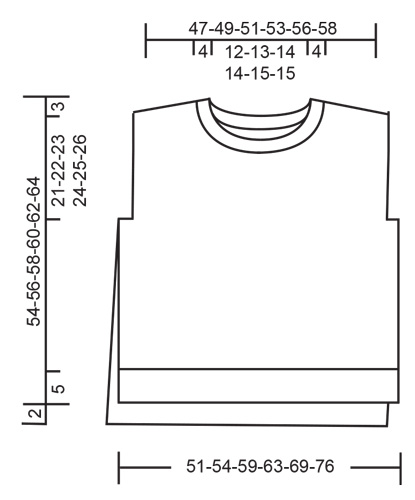 |
|
Have you finished this pattern?Tag your pictures with #dropspattern #driftwoodvest or submit them to the #dropsfan gallery. Do you need help with this pattern?You'll find 27 tutorial videos, a Comments/Questions area and more by visiting the pattern on garnstudio.com. © 1982-2025 DROPS Design A/S. We reserve all rights. This document, including all its sub-sections, has copyrights. Read more about what you can do with our patterns at the bottom of each pattern on our site. |
|







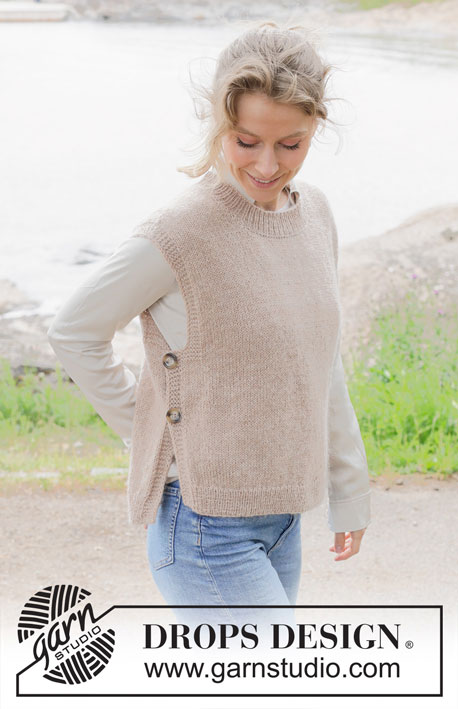
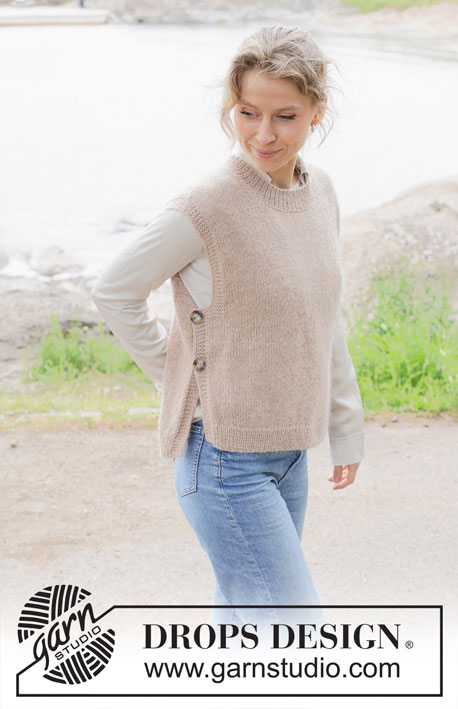

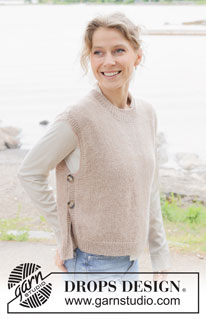
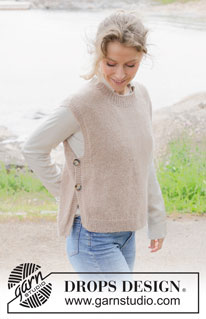
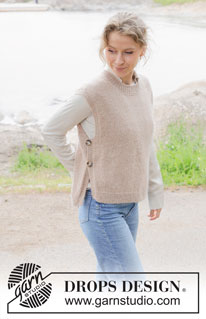

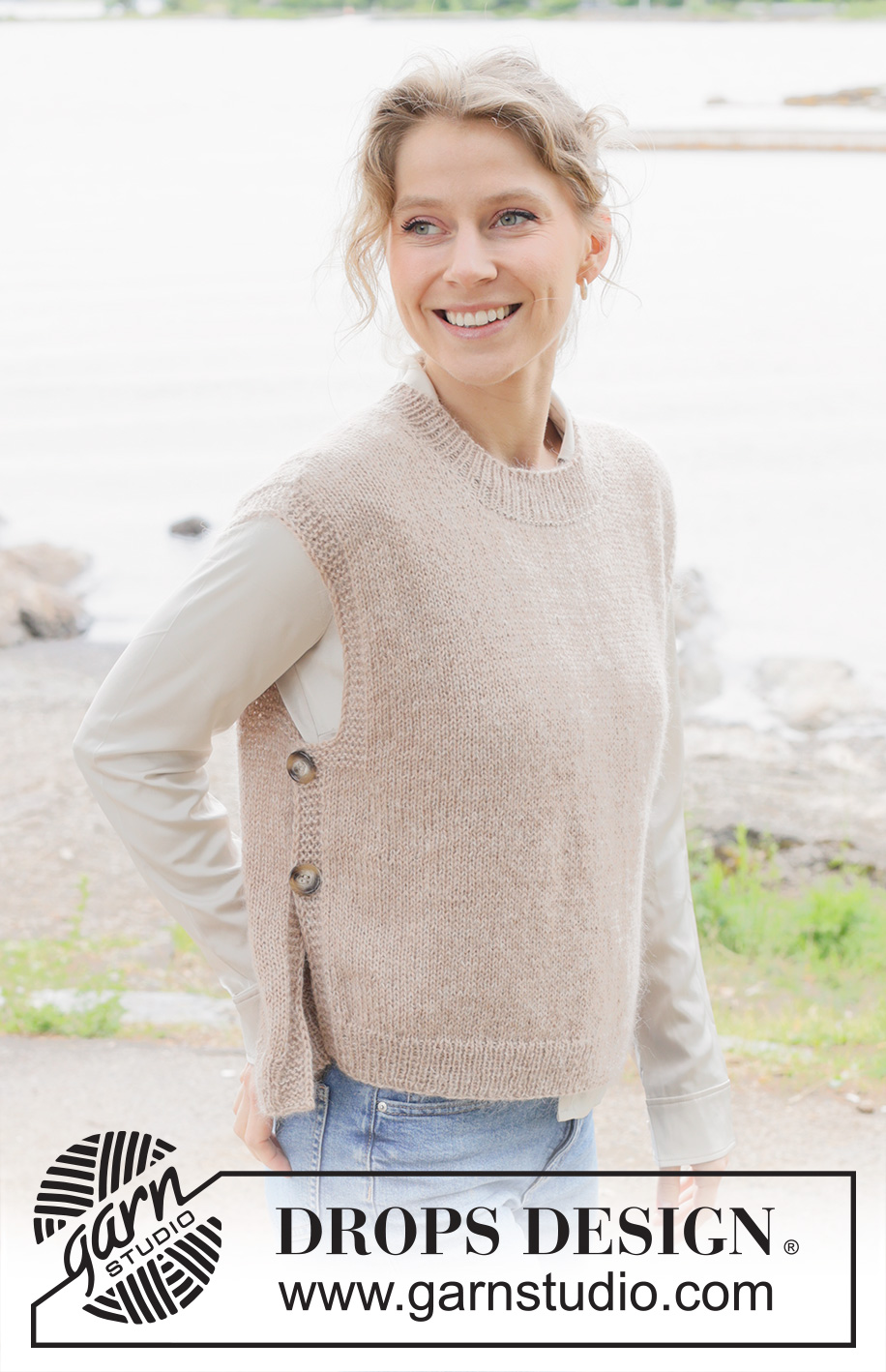
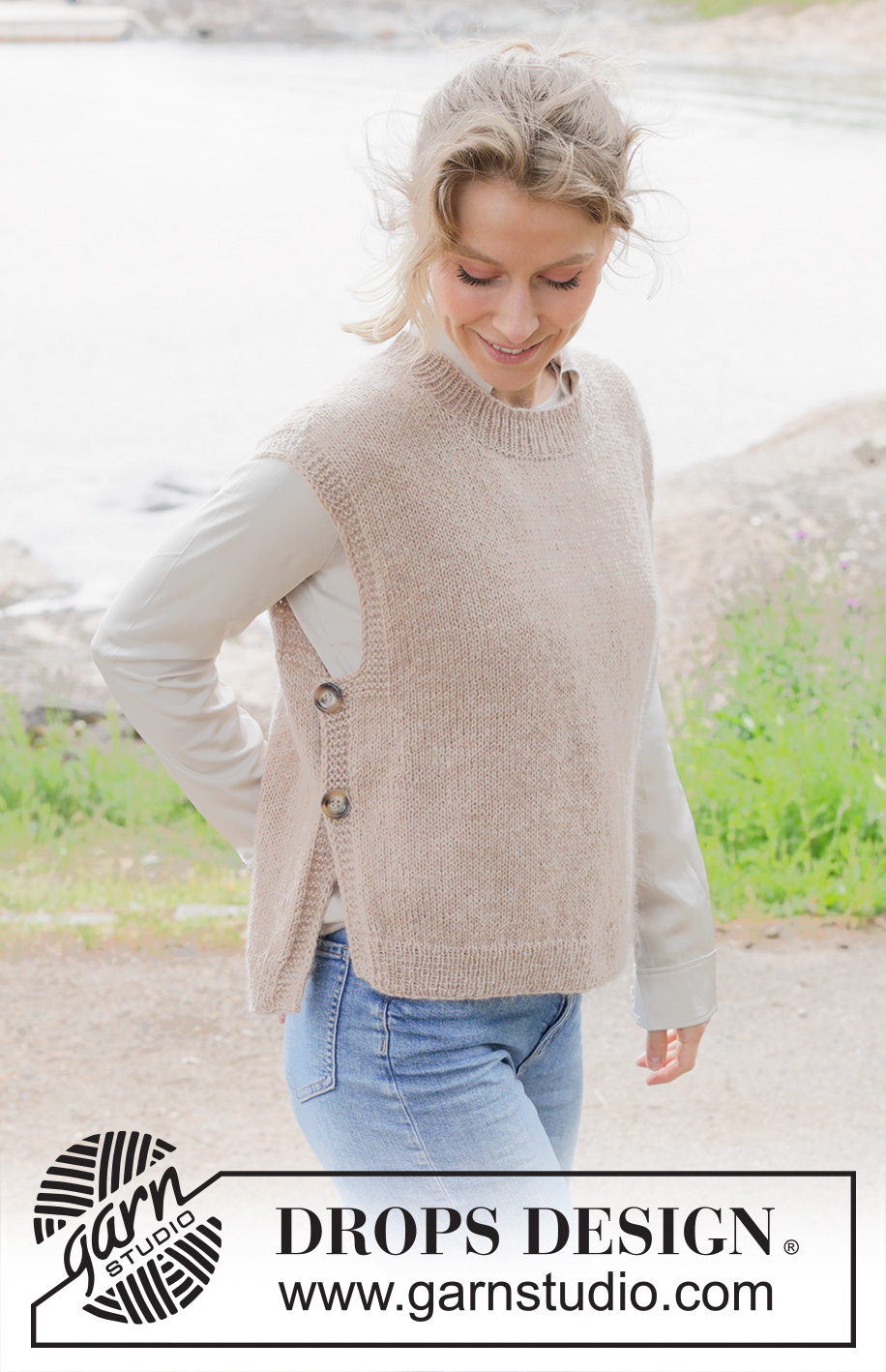
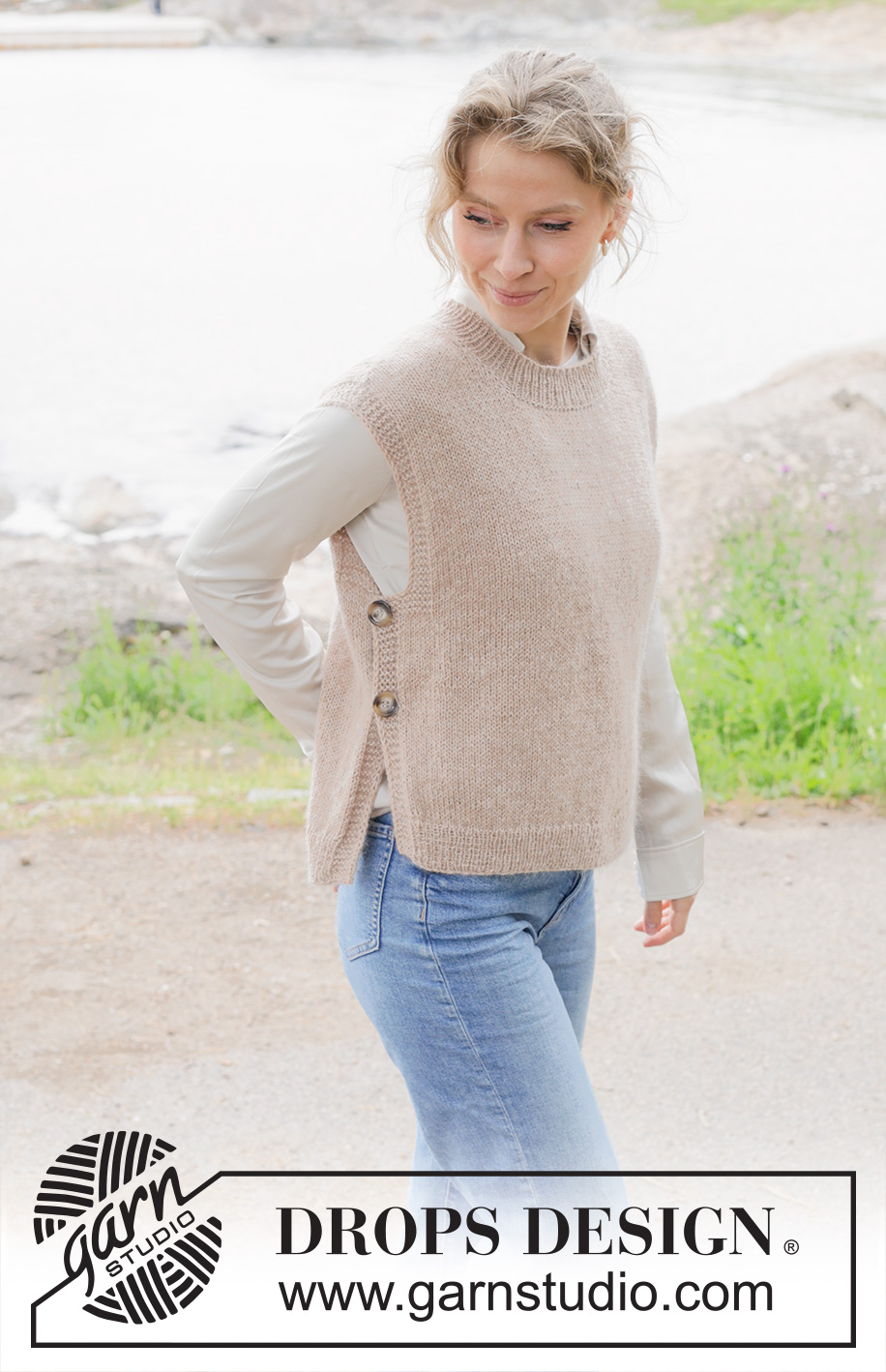

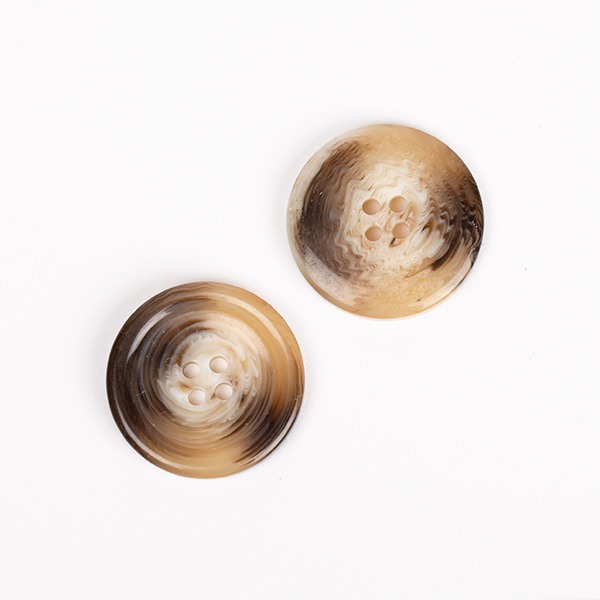



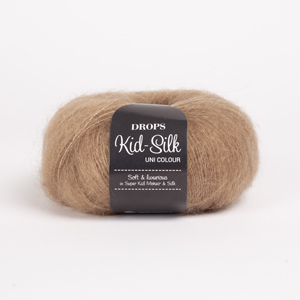

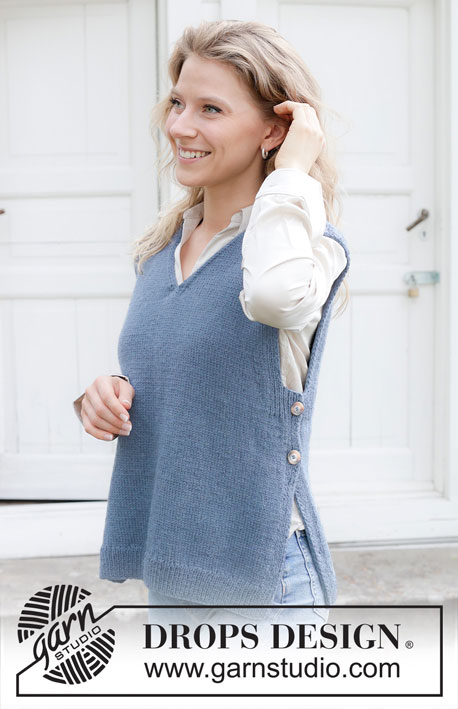














































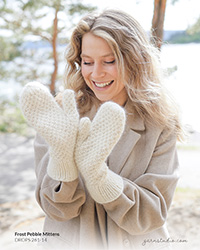


Post a comment to pattern DROPS 255-9
We would love to hear what you have to say about this pattern!
If you want to leave a question, please make sure you select the correct category in the form below, to speed up the answering process. Required fields are marked *.